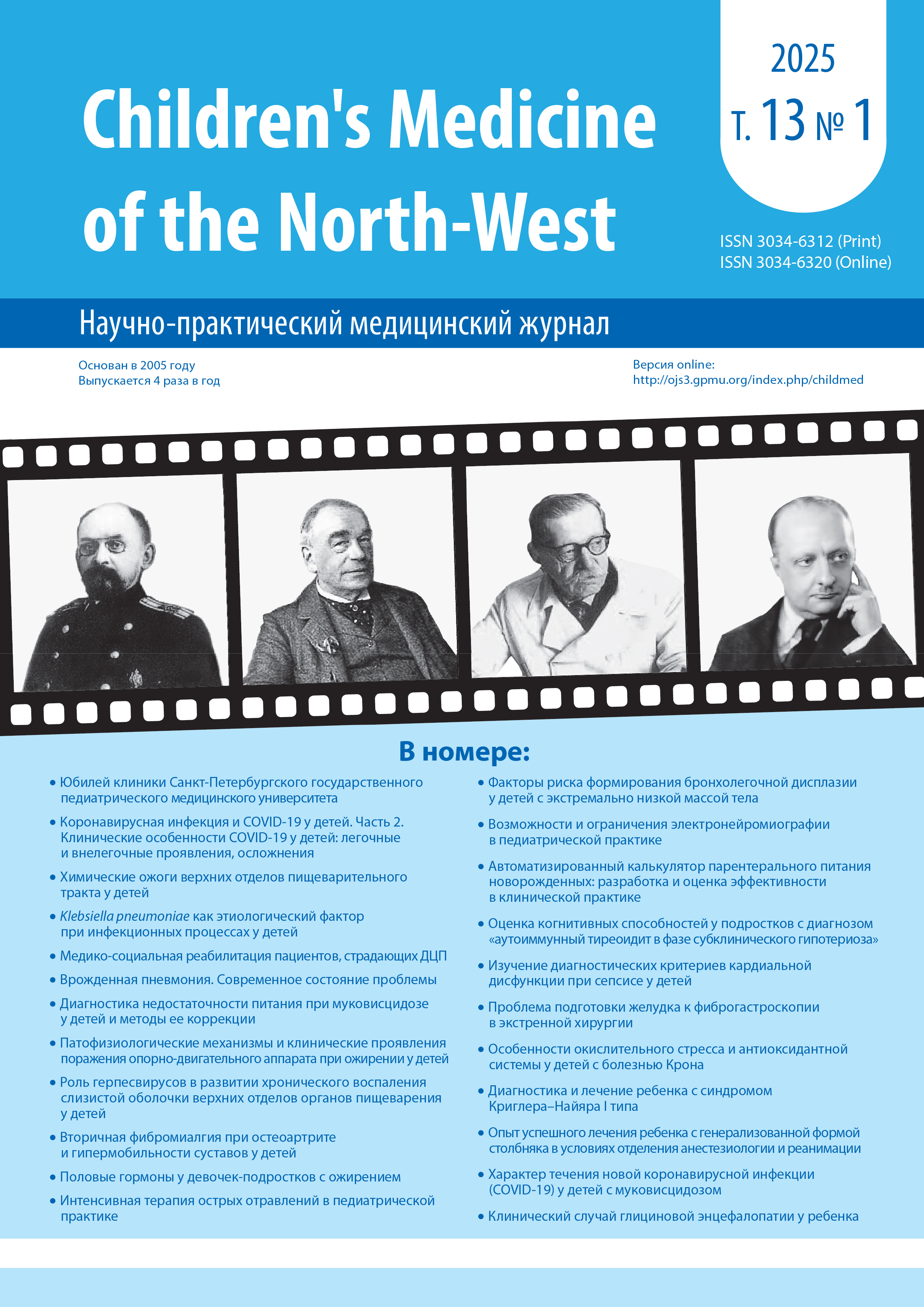SEX HORMONES IN OBESE ADOLESCENT GIRLS. LITERATURE REVIEW
Abstract
The article presents a review of the scientific literature on the problem of the relationship between sex hormones and obesity in adolescent girls. The relationship between overweight and gynecological disorders is in the center of attention of many researchers. Childhood obesity is a non-communicable pandemic and is a major problem worldwide. As the prevalence of this condition increases, there is increasing evidence of an association between obesity and risk factors for menstrual disorders. Excess adipose tissue deposition has both short- and long-term adverse effects on reproductive health. The formation of female reproductive health is of great importance not only in medical, but also in social aspects, as this parameter is a determinant in the development of the population in terms of demographic prospects. The most important stage in this process is the maturation and differentiation of the reproductive system during puberty, when the child's organism transitions from the state of “juvenile pause” to the phase of active sexual development, which is based on the sequential functional activation of hierarchically interrelated departments of the hypothalamic-pituitary-gonadal axis (HGH-axis). The issues of sex hormone metabolism and the participation of adipose tissue in it at normal body weight and in obesity are considered. Adipose tissue is an endocrine organ secreting more than 30 hormones that participate in metabolic and immune mechanisms, acting at local and systemic levels. The influence of excessive amount of adipose tissue on the timing of puberty, as well as its role in the formation of complications from the reproductive system and the mechanism of their development with changes in hormonal status is evaluated.
References
Phelps Nowell H. et al. Worldwide trends in underweight and obesity from 1990 to 2022: a pooled analysis of 3663 population-representative studies with 222 million children, adolescents, and adults. The Lancet. 2024;403(10431):1027–1050. DOI: 10.1016/S0140-6736
(23)02750-2.
Автомонова Т.С., Алешина Е.И., Афончикова О.Л., Ахметов И.И., Барышникова Н.В., Бельмер С.В., Белоусова Л.Н., Воронцова Л.В., Гуркина Е.Ю., Гурова М.М., Гусева А.А., Егорова Э.С., Калашникова В.А., Калинина Е.Ю., Кедринская А.Г., Комиссарова М.Ю., Комолкин И.А., Косенкова Т.В., Краснов А.И., Кузьмина Д.А. и др. Мультидисциплинарные проблемы ожирения у детей. СПб.: СПбГПМУ; 2019.
Gritsinskaya V.L., Novikova V.P. Obesity in children in the regions of Russia. Arch Dis Child. 2021;106
(Suppl 2):A87.1–A87. DOI: 10.1136/archdischild-2021-europaediatrics.205.
Грицинская В.Л., Новикова В.П., Хавкин А.И. К вопросу об эпидемиологии ожирения у детей и подростков (систематический обзор и мета-анализ научных публикаций за 15-летний период). Вопросы практической педиатрии. 2022;17(2):126–135. DOI: 10.20953/1817-7646-2022-2-126-135.
Kinlen D., Cody D., O’Shea D. Complications of obesity. QJM: An International Journal of Medicine. 2018;111(7):437–443. DOI: 10.1093/qjmed/hcx152.
Baer H.J., Colditz G.A., Willett W.C., Dorgan J.F. Adiposity and Sex Hormones in Girls. Cancer Epidemiology, Biomarkers & Prevention. 2007;16(9):1880–1888. DOI: 10.1158/1055-9965.EPI-07-0313.
Reinehr T., Wolters B., Knop C., Lass N., Holl R.W. Strong Effect of Pubertal Status on Metabolic Health in Obese Children: A Longitudinal Study. The Journal of Clinical Endocrinology & Metabolism. 2015;100(1):301–308. DOI: 10.1210/jc.2014-2674.
Калинченко С.Ю., Тюзиков И.А., Тишова Ю.А., Ворслов Л.О. Роль тестостерона в женском организме. Общая и возрастная эндокринология тестостерона у женщин. Доктор.Ру. 2015;115(14):59–64.
Gambineri A., Pelusi C. Sex hormones, obesity and type 2 diabetes: is there a link? Endocrine Connections. 2019;8(1):1–9. DOI: 10.1530/EC-18-0450.
Leeners B., Geary N., Tobler P.N., Asarian L. Ovarian hormones and obesity. Human Reproduction Update. 2017;23(3):300–321. DOI: 10.1093/humupd/dmw045.
Романцова Т.И. Жировая ткань: цвета, депо и функции. Ожирение и метаболизм. 2021;18(3):282–301. DOI: 10.14341/omet12748.
Балашов А.Л., Богданова Н.М., Бойцова Е.В., Лагно О.В., Листопадова А.П., Маталыгина О.А., Нестеренко З.В., Новикова В.П., Похлебкина А.А., Трухманов М.С., Шаповалова Н.С., Шестакова М.Д. Анатомо-физиологические особенности, методы обследования, семиотика и синдромы поражения эндокринной системы у детей: учебно-методическое пособие для студентов 4 курса лечебного факультета по дисциплине «Педиатрия». СПб.: СПбГПМУ; 2021.
Burt Solorzano C.M., McCartney C.R. Obesity and the pubertal transition in girls and boys. Reproduction. 2010;140(3):399–410. DOI: 10.1530/REP-10-0119.
Zhai L., Liu J., Zhao J., Liu J., Bai Y., Jia L. et al. Association of Obesity with Onset of Puberty and Sex Hormones in Chinese Girls: A 4-Year Longitudinal Study. PLOS ONE. 2015;10(8). DOI: 10.1371/journal.pone.0134656.
Шогирадзе Л.Д., Грачева О.В., Мильнер Е.Б., Похлебкина А.А., Гурина О.П., Блинов А.Е., Варламова О.Н., Новикова В.П. Гормональный статус девочек-подростков, страдающих ожирением. В кн.: Куликов А.М., ред., Ипполитова М.Ф., ред. Современные проблемы подростковой медицины и репродуктивного здоровья молодежи. СПб.: Санкт-Петербургский общественный фонд «Поддержка медицины»; 2021:173–174.
Евдокимова Н.В., Шогирадзе Л.Д., Похлебкина А.А., Петренко Ю.В., Михнина Е.А., Новикова В.П., Глушаков Р.И., Прохорова Н.Д., Бунтовская А.С., Трандина А.Е., Беженарь В.Ф. Генетические детерминанты ожирения у девочек-подростков. Российский вестник перинатологии и педиатрии. 2024;69(2):65–71. DOI: 10.21508/1027-4065-2024-69-2-65-71.



